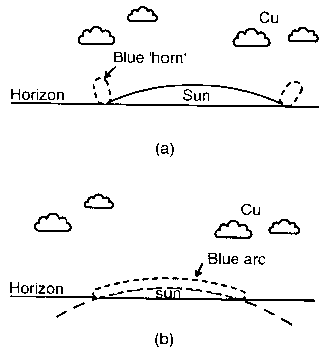 |
Science Frontiers ONLINE No. 108: Nov-Dec 1996 |
|
|
A Blue Flash
Green flashes occasionally appear when the sun (or moon or Venus or Jupiter) sink below the horizon. Blue flashes are much rarer but still well-recognized phenomena. An example of the latter was observed in 1995 on the Indian Ocean.
August 11, 1995, Bay of Bengal. Aboard the m.v. Repulse Bay enroute Jeddah to Port Klang.
"Prior to sunset the vessel was proceeding due east across the Bay of Bengal and it was quite apparent that the sun was still very bright and had not taken on its usual darkorange or red appearance; even with half its diameter above the horizon, the sun was much too bright to view directly. As the last segment of the sun dipped below the horizon, a blue 'horn' formed at each end of it, as shown in sketch (a), and these then closed up to form a bright-blue arc, as shown in sketch (b)."
(Leslie, A.J.; "Blue Flash," Marine Observer, 66:115, 1996)
Comment. The blue flash is a shorter-wavelength version of the green flash. The basic phenomenon is explained in terms of dispersion of the sun's spectrum by the atmosphere near the horizon. Even so, many enigmas remain about these low-sun phenomena. There have been observed: multiple flashes, flashes preceding sunset, complex flash structures, and the apparent psychological origin of some flashes. For details, see GEL1 in Rare Halos, Mirages. This book is described here.
